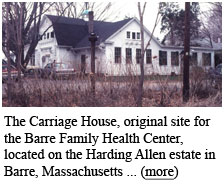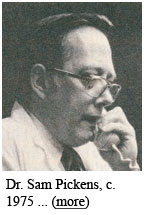The Programs
The Barre Family Health Center
Richard Walton founded the Barre Family Health Center in March, 1973 with the help of its founding medical director, Dr. Gene Roy. As
Walton recalled, Dr. Roy had had a longtime practice in "the Brookfields," but was intrigued by the possibility of starting a residency
 in Family Medicine. Because some of the townspeople of Barre objected to the program's occupying the former Carriage House of the
Harding Allen estate in the center of Barre, there was a delay during which Dr. Roy became their on-site carpenter, renovating the place
to meet state and local standards. (For example, it took a while to get the local inspector to approve their fire alarm system, until
they realized he was partially deaf.) It was intended as the ambulatory site for the underserved of Barre and other nearby communities
in this largely rural part of the state. Walton negotiated an affiliation for the center with Holden Hospital partly because he was
already in the process of planning for a family medicine residency at UMMS, and partly because a small community hospital like Holden
could sorely use the services of the residents and the referrals which the health center would send it. (Of course, as Walton readily
admitted, having Holden Hospital's medical administrator as one of his own patients didn't hurt Walton's chances.)(63)
in Family Medicine. Because some of the townspeople of Barre objected to the program's occupying the former Carriage House of the
Harding Allen estate in the center of Barre, there was a delay during which Dr. Roy became their on-site carpenter, renovating the place
to meet state and local standards. (For example, it took a while to get the local inspector to approve their fire alarm system, until
they realized he was partially deaf.) It was intended as the ambulatory site for the underserved of Barre and other nearby communities
in this largely rural part of the state. Walton negotiated an affiliation for the center with Holden Hospital partly because he was
already in the process of planning for a family medicine residency at UMMS, and partly because a small community hospital like Holden
could sorely use the services of the residents and the referrals which the health center would send it. (Of course, as Walton readily
admitted, having Holden Hospital's medical administrator as one of his own patients didn't hurt Walton's chances.)(63)
 Tragically, Dr. Roy died just before the first class of residents was to begin. Walton also had hired a former surgical resident
from Memorial, Dr. Sam Pickens for the Barre site and, after Dr. Roy's sudden death, he became medical director. Pickens had
just returned to the United States after a thirteen-year stint in India practicing general medicine, including lots of surgery and
obstetrics. He had trained as a surgeon specifically to be able to carry on a general practice in an underserved setting. And that is
what Pickens was also looking to do when he and his wife returned to Massachusetts in the early 1970s.
Tragically, Dr. Roy died just before the first class of residents was to begin. Walton also had hired a former surgical resident
from Memorial, Dr. Sam Pickens for the Barre site and, after Dr. Roy's sudden death, he became medical director. Pickens had
just returned to the United States after a thirteen-year stint in India practicing general medicine, including lots of surgery and
obstetrics. He had trained as a surgeon specifically to be able to carry on a general practice in an underserved setting. And that is
what Pickens was also looking to do when he and his wife returned to Massachusetts in the early 1970s.
He little knew how much of his improvisatory skills from his years in India would be required to start up the new center. Here are some of Dr. Pickens's recollections of the early years at the Barre Health Center:
Dr. [Gene] Roy, who was a carpenter besides being a doctor [in West Brookfield], helped renovate [the carriage house]. He was there, we had one nurse, one office manager, and one secretary, and a lab technician - four people. Then I came on in Aug. of '73, it had opened in April of '73, and we didn't see many patients in those days, because people said, are these guys going to stay here or not? So it took a while to build up, but by the fall, by the first of '74, we had a good number of patients. Then the residency started in '74 … In those days, residents lived up in the carriage house. Upstairs was a place with stories about a ghost there, but that was one story, and the other story was that I got a call one night and it was Dr. Miller, [who] said, "Sam, there's some noise going on - come over here. Somebody's trying to break in." So I called the police, and went over there. There was a guy trying to break in to the drug closet. The police went in with their guns…
Again, from Dr. Sam Pickens:
[There was] a hurricane, [and there were] no lights on, so we had to wheel a guy outside and we sewed him up outside on that veranda by the moonlight, with a flashlight out there. Dr. Earls and Dr. Stenger probably have more stories than I can think of… [We'd go on] the ambulances runs… We don't do that much anymore… [Once,] I was riding in an ambulance, and I took this man in with a heart attack. I went to Memorial. And on the way back, we were going through Rutland, they had a call, "come, come, we need help." And there was a house in which there was carbon monoxide poisoning. So I had to go and pick people out of the house for that and took them down to UMass … Now most of the cases that get picked up, either the paramedics pick them up or they just go right straight to the hospital.
One night I was on–it was in winter–with Dr. [Mike] Ennis, and there was a big accident on the road here, and in those days as you know we were called for accidents more often than now. And a person died and we had to go down the side of the road on 122 to get people out, and I brought one person here and he [Ennis] took the woman who was dying to the hospital, and it was very, very cold, I remember that. That's one story, and the other story was, a patient called me up and said, "I'm in labor," and I said "OK," and [she came] to the health center and I examined her and she was ready to have a baby. And so I said, "OK." And she said, "my car broke down," so I said, "OK, get in my car. [We were] in my car and we were going along on Oakham, and we [came] along and there's another car stopped there, and I stopped and I said, "what's happening," and they said, "this guy has broken his leg." I said, "get in the car." [We drove] to St. Vincent's and I went into the ER and I said, "I need two gurneys here, one for this person who is in labor and is about ready to have the baby and the other guy with a broken leg," and they brought two gurneys out and then they took the woman up and she delivered in half an hour.
In Pickens' view, the key to their success at Barre—where everything was new—lay in establishing "good relationships" with the residents, not just the patients. There was no other way to succeed in a situation with no pre-established roadmaps:
[The residents] taught me how to run things and I taught them, I guess, some of the things that I knew. It was a fact that everyone had to work out the program because we had nothing down. We had no blueprint that said you're going to do this. For instance, the fact of evening rounds. We have evening rounds here now, which starts from 4:30 to 5:30. That was started in the beginning in Barre, and the others didn't have that. Main Street didn't have that until later on. And we do a different style here. We've presented at national meetings about that, because our style was different. But that we started from the beginning. We sat in the office of the director and we discussed patients which we had seen that day, and they talked. We did a lot of trauma here more than other places because we're in the country and people do things to themselves, things like drownings and accidents. In those days, we saw a lot of everything; now, the rescue squads usually take trauma patients right straight in [to the hospital] but we saw all those in the beginning. So, those things they had to learn. We had to learn a chart system, which we didn't have - that was new for us, we don't do that anymore, those kinds of things. The lab was different - we took our own x-rays at night, developed them, in the old days we didn't have an automatic machine. At night the residents did the blood work on patients, and set fractures and all that stuff.(64)
